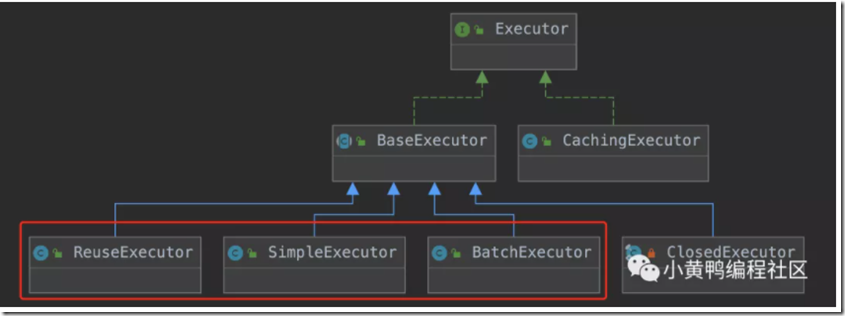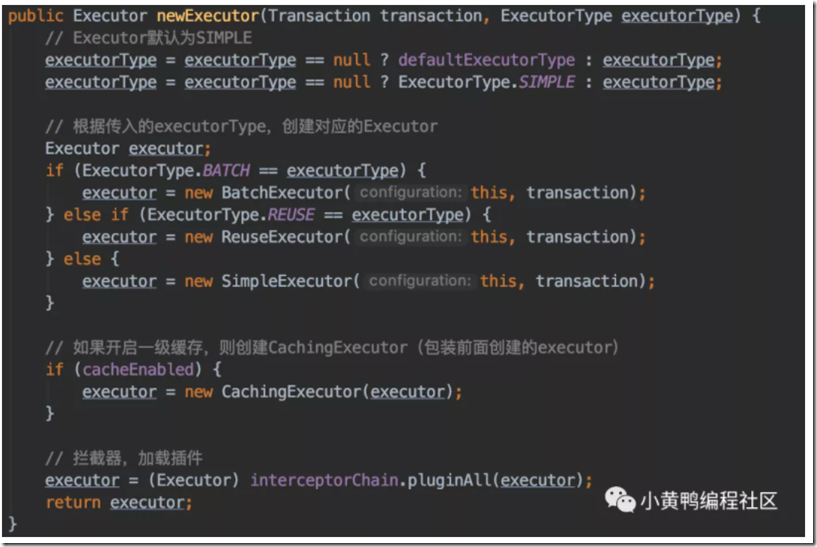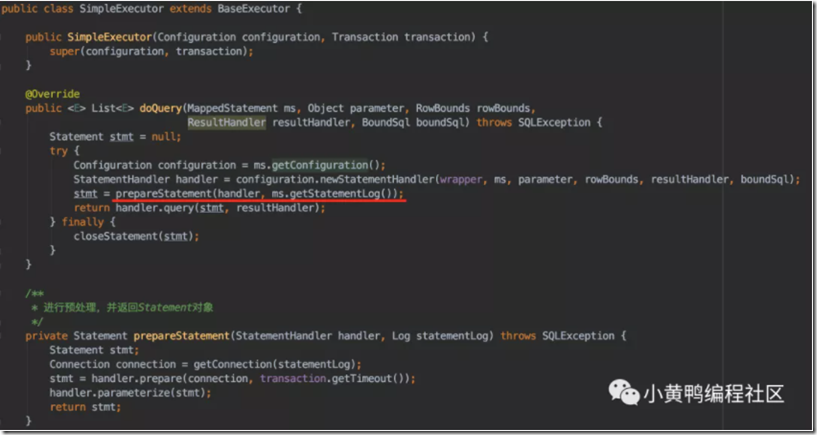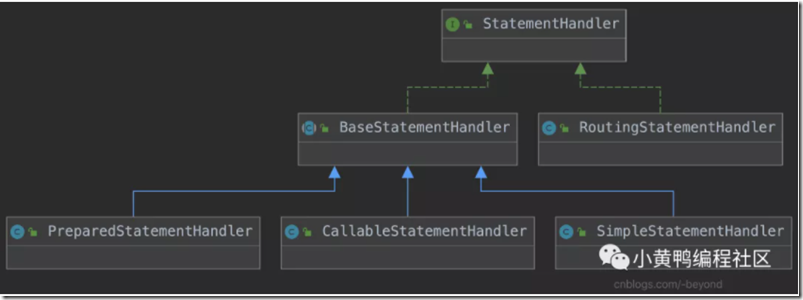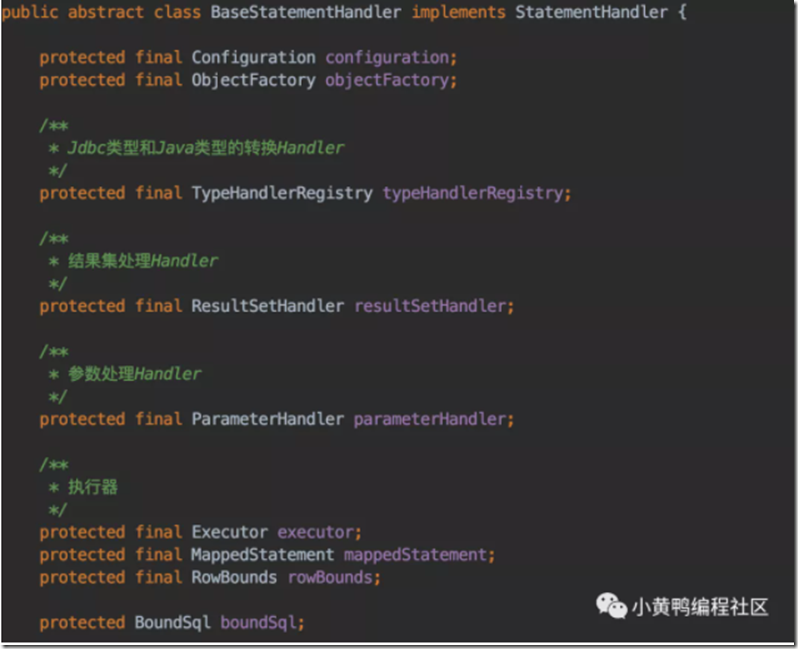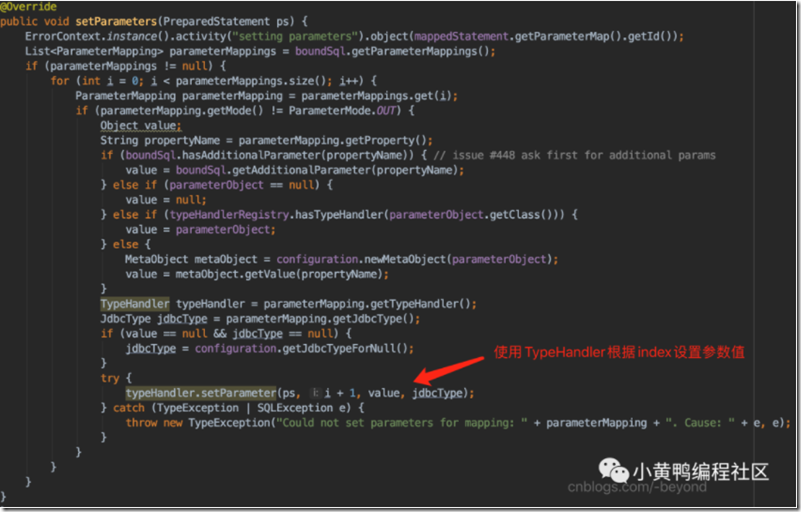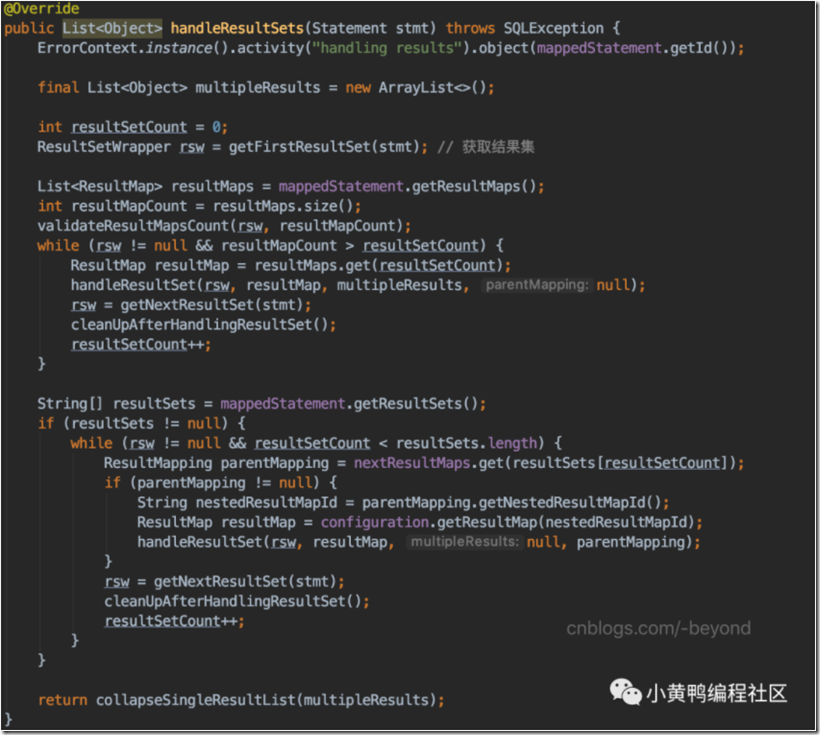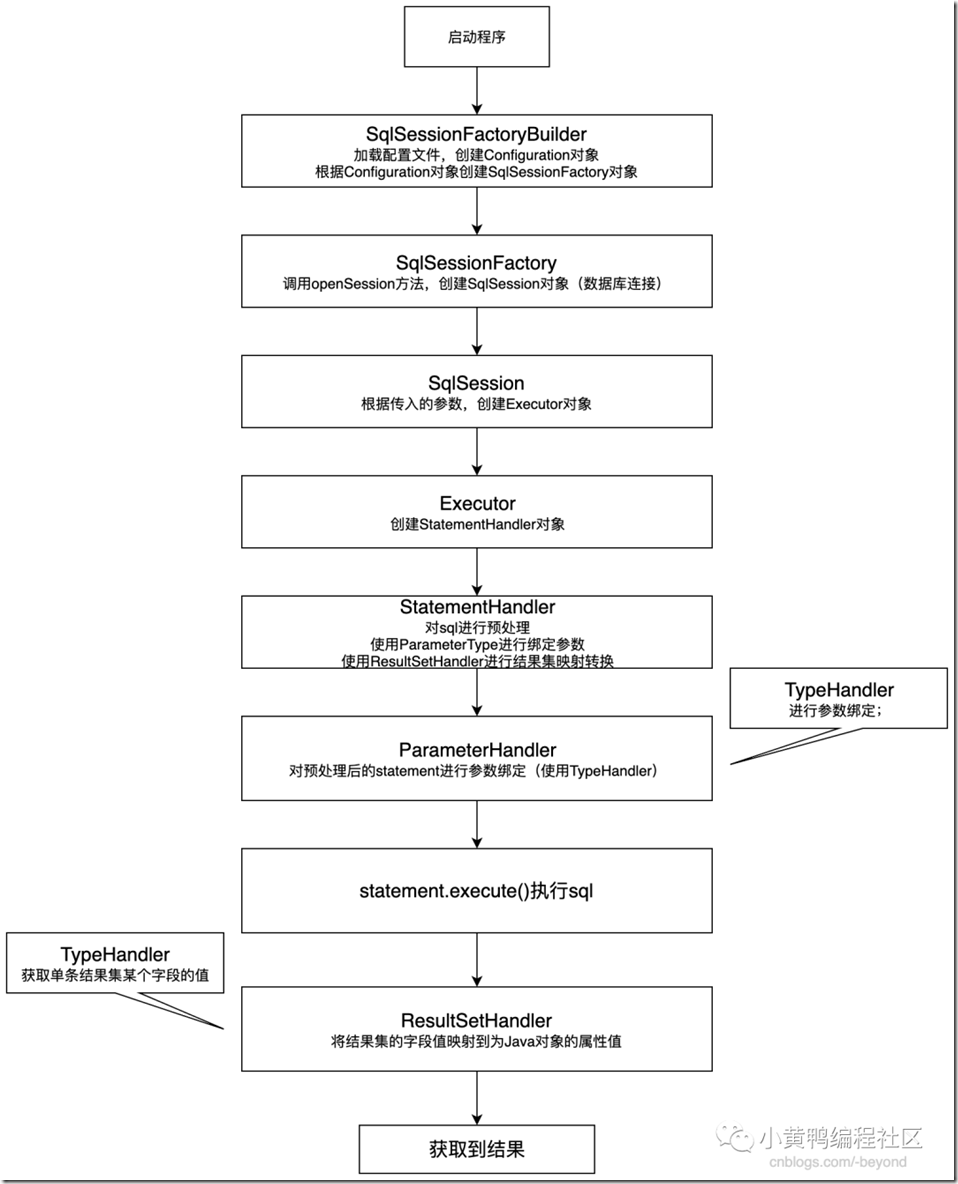1. mybatis的几大“组件”
我这里说的“组件”,可以理解为Mybatis执行过程中的很重要的几个模块。
1.1 SqlSessionFactoryBuilder
从名称长可以看出来使用的建造者设计模式(Builder),用于构建SqlSessionFactory对象
1.解析mybatis的xml配置文件,然后创建Configuration对象(对应<configuration>标签);
2.根据创建的Configuration对象,创建SqlSessionFactory(默认使用DefaultSqlSessionFactory);
1.2 SqlSessionFactory
从名称上可以看出使用的工厂模式(Factory),用于创建并初始化SqlSession对象(数据库会话)
1.调用openSession方法,创建SqlSession对象,可以将SqlSession理解为数据库连接(会话);
2.openSession方法有多个重载,可以创建SqlSession关闭自动提交、指定ExecutorType、指定数据库事务隔离级别….
package org.apache.ibatis.session; import java.sql.Connection; public interface SqlSessionFactory { /** * 使用默认配置 * 1.默认不开启自动提交 * 2.执行器Executor默认使用SIMPLE * 3.使用数据库默认的事务隔离级别 */ SqlSession openSession(); /** * 指定是否开启自动提交 * @param autoCommit 是否开启自动提交 */ SqlSession openSession(boolean autoCommit); /** * 根据已有的数据库连接创建会话(事务) * @param connection 数据库连接 */ SqlSession openSession(Connection connection); /** * 创建连接时,指定数据库事务隔离级别 * @param level 事务隔离界别 */ SqlSession openSession(TransactionIsolationLevel level); /** * 创建连接时,指定执行器类型 * @param execType 执行器 */ SqlSession openSession(ExecutorType execType); SqlSession openSession(ExecutorType execType, boolean autoCommit); SqlSession openSession(ExecutorType execType, TransactionIsolationLevel level); SqlSession openSession(ExecutorType execType, Connection connection); /** * 获取Configuration对象,也就是解析xml配置文件中的<configuration>标签后的数据 */ Configuration getConfiguration(); }
1.3 SqlSession
如果了解web开发,就应该知道cookie和session吧,SqlSession的session和web开发中的session概念类似。
session,译为“会话、会议”,数据的有效时间范围是在会话期间(会议期间),会话(会议)结束后,数据就清除了。
也可以将SqlSession理解为一个数据库连接(但也不完全正确,因为创建SqlSession之后,如果不执行sql,那么这个连接是无意义的,所以数据库连接在执行sql的时候才建立的)。
SqlSession是一个接口,定义了很多操作数据库的方法声明:
public interface SqlSession extends Closeable { /* 获取数据库连接 */ Connection getConnection(); /* 数据库的增删改查 */ <T> T selectOne(String statement); <E> List<E> selectList(String statement); int update(String statement, Object parameter); int delete(String statement, Object parameter); /* 事务回滚与提交 */ void rollback(); void commit(); /* 清除一级缓存 */ void clearCache(); // 此处省略了很多方法 }
SqlSession只是定义了执行sql的一些方法,而具体的实现由子类来完成,比如SqlSession有一个接口实现类DefaultSqlSession。
MyBatis中通过Executor来执行sql的,在创建SqlSession的时候(openSession),同时会创建一个Executor对象,如下:
@Override public SqlSession openSession() { return openSessionFromDataSource(configuration.getDefaultExecutorType(), null, false); } private SqlSession openSessionFromDataSource(ExecutorType execType, TransactionIsolationLevel level, boolean autoCommit) { Transaction tx = null; try { final Environment environment = configuration.getEnvironment(); final TransactionFactory transactionFactory = getTransactionFactoryFromEnvironment(environment); tx = transactionFactory.newTransaction(environment.getDataSource(), level, autoCommit); // 利用传入的参数,创建executor对象 final Executor executor = configuration.newExecutor(tx, execType); return new DefaultSqlSession(configuration, executor, autoCommit); } catch (Exception e) { closeTransaction(tx); // may have fetched a connection so lets call close() throw ExceptionFactory.wrapException("Error opening session. Cause: " + e, e); } finally { ErrorContext.instance().reset(); } }
1.4 Executor
Executor(人称“执行器”)是一个接口,定义了对JDBC的封装;
MyBatis中提供了多种执行器,如下:
上面的图中,虽然列出了5个Executor(BaseExecutor是抽象类),其实Executor只有三种:
public enum ExecutorType { SIMPLE, // 简单 REUSE, // 复用 BATCH; // 批量 }
CacheExecutor其实是一个Executor代理类,包含一个delegate,需要创建时手动传入(要入simple、reuse、batch三者之一);
ClosedExecutor,所有接口都会抛出异常,表示一个已经关闭的Executor;
创建SqlSession时,默认使用的是SimpleExecutor;
下面是创建Executor的代码:org.apache.ibatis.session.Configuration#newExecutor()
上面说了,Executor是对JDBC的封装。当我们使用JDBC来执行sql时,一般会先预处理sql,也就是conn.prepareStatement(sql),获取返回的
PreparedStatement对象(实现了Statement接口),再调用statement的executeXxx()来执行sql。
也就是说,Executor在执行sql的时候也是需要创建Statement对象的,下面以SimpleExecutor为例
1.5 StatementHandler
在JDBC中,是调用Statement.executeXxx()来执行sql;
在MyBatis,也是调用Statement.executeXxx()来执行sql,此时就不得不提StatementHandler,可以将其理解为一个工人,他的工作包括
1.对sql进行预处理;
2.调用statement.executeXxx()执行sql;
3.将数据库返回的结果集进行对象转换(ORM);
public interface StatementHandler { /** * 获取预处理对象 */ Statement prepare(Connection connection, Integer transactionTimeout) throws SQLException; /** * 进行预处理 */ void parameterize(Statement statement) throws SQLException; /** * 批量sql(内部调用statement.addBatch) */ void batch(Statement statement) throws SQLException; /** * 执行更新操作 * @return 修改的记录数 */ int update(Statement statement) throws SQLException; /** * 执行查询操作 * @param statement sql生成的statement * @param resultHandler 结果集的处理逻辑 * @return 查询结果 */ <E> List<E> query(Statement statement, ResultHandler resultHandler) throws SQLException; <E> Cursor<E> queryCursor(Statement statement) throws SQLException; BoundSql getBoundSql(); ParameterHandler getParameterHandler(); }
StatementHandler的相关子类如下图所示:
以BaseStatementHandler为例:
1.6 ParameterHandler
ParameterHandler的功能就是sql预处理后,进行设置参数:
public interface ParameterHandler { Object getParameterObject(); void setParameters(PreparedStatement ps) throws SQLException; }
1.7 ResultSetHandler
当执行statement.execute()后,就可以通过statement.getResultSet()来获取结果集,
获取到结果集之后,MyBatis会使用ResultSetHandler来将结果集的数据转换为Java对象(ORM映射)
public interface ResultSetHandler { /** * 从statement中获取结果集,并将结果集的数据库属性字段映射到Java对象属性 * @param stmt 已经execute的statement,调用state.getResultSet()获取结果集 * @return 转换后的数据 */ <E> List<E> handleResultSets(Statement stmt) throws SQLException;
<E> Cursor<E> handleCursorResultSets(Statement stmt) throws SQLException; void handleOutputParameters(CallableStatement cs) throws SQLException; }
ResultSetHandler有一个实现类,DefaultResultHandler,其重写handlerResultSets方法,如下:
1.8 TypeHandler
TypeHandler主要用在两个地方:
1.参数绑定,发生在ParameterHandler.setParamenters()中。
MyBatis中,可以使用<resultMap>来定义结果的映射关系,包括每一个字段的类型,比如下面这样:
<resultMap id="baseMap" type="cn.ganlixin.model.User"> <id column="uid" property="id" jdbcType="INTEGER" /> <result column="uname" property="name" jdbcType="VARCHAR" /> </resultMap>
2.获取结果集中的字段值,发生在ResultSetHandler处理结果集的过程中。
TypeHandler的定义如下
public interface TypeHandler<T> { /** * 设置预处理参数 * * @param ps 预处理statement * @param i 参数位置 * @param parameter 参数值 * @param jdbcType 参数的jdbc类型 */ void setParameter(PreparedStatement ps, int i, T parameter, JdbcType jdbcType) throws SQLException; /** * 获取一条结果集的某个字段值 * * @param rs 一条结果集 * @param columnName 列名(字段名称) * @return 字段值 */ T getResult(ResultSet rs, String columnName) throws SQLException; /** * 获取一条结果集的某个字段值(按照字段的顺序获取) * * @param rs 一条结果集 * @param columnIndex 字段列的顺序 * @return 字段值 */ T getResult(ResultSet rs, int columnIndex) throws SQLException; T getResult(CallableStatement cs, int columnIndex) throws SQLException; }
2. 总结
把执行的流程总结一下:
